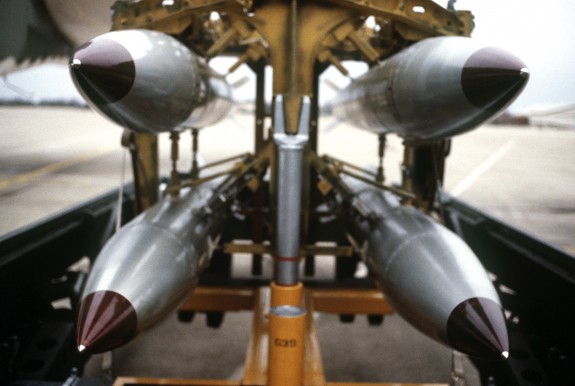The U.S. Is About To Drop $10 Billion Retrofitting Its Nukes
The military wants to upgrade its 1960s-era nuclear workhorse

Image: Department of Defense
Housed in bases across Europe, roughly 400 American B61 nuclear bombs are beginning to creak with old age. Designed in the 1960s, “the B61 was once heralded as a cornerstone of the country’s air-delivered nuclear force,” says the Washington Post.
Developed as a major deterrent against Soviet aggression in Europe, it is a slender gray cylinder that weighs 700 pounds and is 11 feet long and 13 inches in diameter. It can be delivered by a variety of aircraft, including NATO planes, anywhere in the world.
Now, the military is planning to lay down roughly $10 billion to upgrade the aging weapons, building in GPS guidance systems and replacing old parts. The price tag of the retrofits has crept ever-upward since the plan was first introduced.
These upgrades, says the Pentagon to Noah Shachtman for Wired, are crucial to “keep this slice of its nuclear arsenal ready for war, if needed.” Wired reports:
Just about the only thing that won’t change is the weapon’s nuclear “pit,” and who the U.S. military plans on dropping the thing on. “Who’s the target? The Red Army. The Red Army that’s sitting in East Germany, ready to plunge into Europe,” explains. Jeffrey Lewis, a nuclear weapons expert at the James Martin Center for Nonproliferation Studies. “No, I’m serious.”
Over the past few decades, America’s nuclear arsenal has continued to shrink, while the costs of maintaining them has continued to rise, says the advocacy organization Global Zero:
The United States is moving into a phase of nuclear modernization that will entail greater spending on nuclear weapons than at any time since the Cold-War Reagan years, and much of the rest of the nuclear-armed world is undergoing similar upgrading of their arsenals at increasing cost. Conservatively estimated, the aggregate spending on nuclear weapons by the nine nuclear weapons countries over the next decade will exceed one trillion dollars.
The B61s, however, are only one small part of the U.S.’s total arsenal. The Washington Post:
The B61s represent less than 10 percent of the 5,113 bombs and missiles that make up the U.S. nuclear arsenal. In the coming decade, updating vast elements of the nation’s nuclear weapons complex — from weapons to delivery systems to the labs and plants that make and test them — is expected to cost at least $352 billion, according to the Stimson Center, another nonpartisan Washington think tank.
More from Smithsonian.com:
Six Guys Stood At Nuclear Ground Zero And Lived To Tell The Tale
Hiroshima, U.S.A.
/https://tf-cmsv2-smithsonianmag-media.s3.amazonaws.com/accounts/headshot/smartnews-colin-schultz-240.jpg)
/https://tf-cmsv2-smithsonianmag-media.s3.amazonaws.com/accounts/headshot/smartnews-colin-schultz-240.jpg)